Study on the Influencing Factors of Forest Tree-Species Classification Based on Landsat and Sentinel-2 Imagery
Abstract
:1. Introduction
2. Study Area and Data Introduction
2.1. Study Area
2.2. Data Introduction
2.2.1. Field Survey Data
2.2.2. Landsat Data
2.2.3. Sentinel-2 Data
3. Method
3.1. Feature Variable Extraction
3.2. Classification Algorithm
3.3. Accuracy Assessment
4. Results
4.1. Forest Tree-Species Classification Results with Different Algorithms
4.2. Forest Tree-Species Classification Results with Different Radiometric Resolutions
4.3. Forest Tree-Species Classification Results with Different Spectral Resolutions
4.4. Forest Tree-Species Classification Results with Different Spatial Resolutions
4.5. Forest Tree-Species Classification Results with Different Seasonal Imagery
4.6. Forest Tree-Species Classification Results with Different Sample Sizes
4.7. Forest Tree-Species Classification Results with Multi-Source Data Integration
4.8. Forest Tree-Species Classification Results with Optimal Scheme
5. Discussion
5.1. Analysis of Differences in Forest-Species Classification between Landsat and Sentinel-2 Imagery Data
5.2. Analysis of Influencing Factors on Forest Tree-Species Classification
6. Conclusions
- (1)
- Among Landsat-8, Landsat-9, and Sentinel-2 imagery, Landsat-9 provides the best tree-species classification results, while Landsat-8 performs the worst. The findings indicate that a higher radiometric resolution improves tree-species classification.
- (2)
- Among the influencing factors such as spectral resolution, spatial resolution, radiometric resolution, classification algorithm, sample size, and image time phase, the impacts of the image time phase and sample size on tree-species classification results are relatively large, each exceeding 10%, while the positive impact of radiometric resolution is the smallest, at only 3.15%. However, the impacts of spectral resolution and spatial resolution on tree-species classification results are negative, at −2.11% and −1.4%, respectively.
- (3)
- Using the RF algorithm with 300 samples per tree species category on 30-m spring Landsat-9 and Sentinel-2 imagery yields the most accurate classification results, achieving an OA of 85.93% and a kappa of 0.84. This represents improvements of 11.72% in accuracy and 0.13 in the kappa coefficient compared to results using only 30-m Landsat-9 imagery.
Supplementary Materials
Author Contributions
Funding
Data Availability Statement
Acknowledgments
Conflicts of Interest
References
- Silva, L.C.R.; Anand, M. Probing for the Influence of Atmospheric CO2 and Climate Change on Forest Ecosystems across Biomes. Glob. Ecol. Biogeogr. 2013, 22, 83–92. [Google Scholar] [CrossRef]
- Torello-Raventos, M.; Feldpausch, T.R.; Veenendaal, E.; Schrodt, F.; Saiz, G.; Domingues, T.F.; Djagbletey, G.; Ford, A.; Kemp, J.; Marimon, B.S.; et al. On the Delineation of Tropical Vegetation Types with an Emphasis on Forest/Savanna Transitions. Plant Ecol. Divers. 2013, 6, 101–137. [Google Scholar] [CrossRef]
- Mellor, A.; Haywood, A.; Stone, C.; Jones, S. The Performance of Random Forests in an Operational Setting for Large Area Sclerophyll Forest Classification. Remote Sens. 2013, 5, 2838–2856. [Google Scholar] [CrossRef]
- Leckie, D.G.; Gougeon, F.; McQueen, R.; Oddleifson, K.; Hughes, N.; Walsworth, N.; Gray, S. Production of a Large-Area Individual Tree Species Map for Forest Inventory in a Complex Forest Setting and Lessons Learned. Can. J. Remote Sens. 2017, 43, 140–167. [Google Scholar] [CrossRef]
- Jurjević, L.; Liang, X.; Gašparović, M.; Balenović, I. Is Field-Measured Tree Height as Reliable as Believed—Part II, A Comparison Study of Tree Height Estimates from Conventional Field Measurement and Low-Cost Close-Range Remote Sensing in a Deciduous Forest. ISPRS J. Photogramm. Remote Sens. 2020, 169, 227–241. [Google Scholar] [CrossRef]
- Pu, R. Mapping Tree Species Using Advanced Remote Sensing Technologies: A State-of-the-Art Review and Perspective. J. Remote Sens. 2021. [Google Scholar] [CrossRef]
- Wang, K.; Franklin, S.E.; Guo, X.; Cattet, M. Remote Sensing of Ecology, Biodiversity and Conservation: A Review from the Perspective of Remote Sensing Specialists. Sensors 2010, 10, 9647–9667. [Google Scholar] [CrossRef] [PubMed]
- Welle, T.; Aschenbrenner, L.; Kuonath, K.; Kirmaier, S.; Franke, J. Mapping Dominant Tree Species of German Forests. Remote Sens. 2022, 14, 3330. [Google Scholar] [CrossRef]
- Walsh, S.J. Coniferous Tree Species Mapping Using LANDSAT Data. Remote Sens. Environ. 1980, 9, 11–26. [Google Scholar] [CrossRef]
- Wessel, M.; Brandmeier, M.; Tiede, D. Evaluation of Different Machine Learning Algorithms for Scalable Classification of Tree Types and Tree Species Based on Sentinel-2 Data. Remote Sens. 2018, 10, 1419. [Google Scholar] [CrossRef]
- Soleimannejad, L.; Ullah, S.; Abedi, R.; Dees, M.; Koch, B. Evaluating the Potential of Sentinel-2, Landsat-8, and Irs Satellite Images in Tree Species Classification of Hyrcanian Forest of Iran Using Random Forest. J. Sustain. For. 2019, 38, 615–628. [Google Scholar] [CrossRef]
- Phiri, D.; Simwanda, M.; Salekin, S.; Nyirenda, V.R.; Murayama, Y.; Ranagalage, M. Sentinel-2 Data for Land Cover/Use Mapping: A Review. Remote Sens. 2020, 12, 2291. [Google Scholar] [CrossRef]
- Isbaex, C.; Coelho, A.M.; Isbaex, C.; Coelho, A.M. The Potential of Sentinel-2 Satellite Images for Land-Cover/Land-Use and Forest Biomass Estimation: A Review. In Forest Biomass—From Trees to Energy; IntechOpen: Rijeka, Croatia, 2021; ISBN 978-1-83962-971-6. [Google Scholar]
- Li, M.; Im, J.; Beier, C. Machine Learning Approaches for Forest Classification and Change Analysis Using Multi-Temporal Landsat TM Images over Huntington Wildlife Forest. GIScience Remote Sens. 2013, 50, 361–384. [Google Scholar] [CrossRef]
- Grabska, E.; Hostert, P.; Pflugmacher, D.; Ostapowicz, K. Forest Stand Species Mapping Using the Sentinel-2 Time Series. Remote Sens. 2019, 11, 1197. [Google Scholar] [CrossRef]
- Thanh Noi, P.; Kappas, M. Comparison of Random Forest, k-Nearest Neighbor, and Support Vector Machine Classifiers for Land Cover Classification Using Sentinel-2 Imagery. Sensors 2018, 18, 18. [Google Scholar] [CrossRef]
- Liu, Y.; Gong, W.; Hu, X.; Gong, J. Forest Type Identification with Random Forest Using Sentinel-1A, Sentinel-2A, Multi-Temporal Landsat-8 and DEM Data. Remote Sens. 2018, 10, 946. [Google Scholar] [CrossRef]
- Immitzer, M.; Neuwirth, M.; Böck, S.; Brenner, H.; Vuolo, F.; Atzberger, C. Optimal Input Features for Tree Species Classification in Central Europe Based on Multi-Temporal Sentinel-2 Data. Remote Sens. 2019, 11, 2599. [Google Scholar] [CrossRef]
- Hościło, A.; Lewandowska, A. Mapping Forest Type and Tree Species on a Regional Scale Using Multi-Temporal Sentinel-2 Data. Remote Sens. 2019, 11, 929. [Google Scholar] [CrossRef]
- Masek, J.G.; Wulder, M.A.; Markham, B.; McCorkel, J.; Crawford, C.J.; Storey, J.; Jenstrom, D.T. Landsat 9: Empowering Open Science and Applications through Continuity. Remote Sens. Environ. 2020, 248, 111968. [Google Scholar] [CrossRef]
- You, H.; Huang, Y.; Qin, Z.; Chen, J.; Liu, Y. Forest Tree Species Classification Based on Sentinel-2 Images and Auxiliary Data. Forests 2022, 13, 1416. [Google Scholar] [CrossRef]
- Broge, N.H.; Leblanc, E. Comparing Prediction Power and Stability of Broadband and Hyperspectral Vegetation Indices for Estimation of Green Leaf Area Index and Canopy Chlorophyll Density. Remote Sens. Environ. 2001, 76, 156–172. [Google Scholar] [CrossRef]
- Haboudane, D.; Miller, J.R.; Tremblay, N.; Zarco-Tejada, P.J.; Dextraze, L. Integrated Narrow-Band Vegetation Indices for Prediction of Crop Chlorophyll Content for Application to Precision Agriculture. Remote Sens. Environ. 2002, 81, 416–426. [Google Scholar] [CrossRef]
- McFeeters, S.K. The Use of the Normalized Difference Water Index (NDWI) in the Delineation of Open Water Features. Int. J. Remote Sens. 1996, 17, 1425–1432. [Google Scholar] [CrossRef]
- Daughtry, C.S.T.; Walthall, C.L.; Kim, M.S.; de Colstoun, E.B.; McMurtrey, J.E. Estimating Corn Leaf Chlorophyll Concentration from Leaf and Canopy Reflectance. Remote Sens. Environ. 2000, 74, 229–239. [Google Scholar] [CrossRef]
- Huete, A.; Justice, C.; Liu, H. Development of Vegetation and Soil Indices for MODIS-EOS. Remote Sens. Environ. 1994, 49, 224–234. [Google Scholar] [CrossRef]
- Broge, N.H.; Mortensen, J.V. Deriving Green Crop Area Index and Canopy Chlorophyll Density of Winter Wheat from Spectral Reflectance Data. Remote Sens. Environ. 2002, 81, 45–57. [Google Scholar] [CrossRef]
- Bolyn, C.; Michez, A.; Gaucher, P.; Lejeune, P.; Bonnet, S. Forest Mapping and Species Composition Using Supervised per Pixel Classification of Sentinel-2 Imagery. Biotechnol. Agron. Société Environ. 2018, 22, 16. [Google Scholar] [CrossRef]
- Bridhikitti, A.; Overcamp, T.J. Estimation of Southeast Asian Rice Paddy Areas with Different Ecosystems from Moderate-Resolution Satellite Imagery. Agric. Ecosyst. Environ. 2012, 146, 113–120. [Google Scholar] [CrossRef]
- Gamon, J.A.; Surfus, J.S. Assessing Leaf Pigment Content and Activity with a Reflectometer. New Phytol. 1999, 143, 105–117. [Google Scholar] [CrossRef]
- le Maire, G.; François, C.; Dufrêne, E. Towards Universal Broad Leaf Chlorophyll Indices Using PROSPECT Simulated Database and Hyperspectral Reflectance Measurements. Remote Sens. Environ. 2004, 89, 1–28. [Google Scholar] [CrossRef]
- Fourty, T.; Baret, F.; Jacquemoud, S.; Schmuck, G.; Verdebout, J. Leaf Optical Properties with Explicit Description of Its Biochemical Composition: Direct and Inverse Problems. Remote Sens. Environ. 1996, 56, 104–117. [Google Scholar] [CrossRef]
- Gitelson, A.A.; Gritz, Y.; Merzlyak, M.N. Relationships between Leaf Chlorophyll Content and Spectral Reflectance and Algorithms for Non-Destructive Chlorophyll Assessment in Higher Plant Leaves. J. Plant Physiol. 2003, 160, 271–282. [Google Scholar] [CrossRef] [PubMed]
- Breiman, L. Random Forests. Mach. Learn. 2001, 45, 5–32. [Google Scholar] [CrossRef]
- Pal, M. Random Forest Classifier for Remote Sensing Classification. Int. J. Remote Sens. 2005, 26, 217–222. [Google Scholar] [CrossRef]
- Vu, Q.-V.; Truong, V.-H.; Thai, H.-T. Machine Learning-Based Prediction of CFST Columns Using Gradient Tree Boosting Algorithm. Compos. Struct. 2021, 259, 113505. [Google Scholar] [CrossRef]
- Pal, M.; Mather, P.M. Support Vector Machines for Classification in Remote Sensing. Int. J. Remote Sens. 2005, 26, 1007–1011. [Google Scholar] [CrossRef]
- Jombo, S.; Adelabu, S. Evaluating Landsat-8, Landsat-9 and Sentinel-2 Imageries in Land Use and Land Cover (LULC) Classification in a Heterogeneous Urban Area. GeoJournal 2023, 88, 377–399. [Google Scholar] [CrossRef]
- Shahfahad, T.S.; Naikoo, M.W.; Rahman, A.; Gagnon, A.S.; Islam, A.R.M.T.; Mosavi, A. Comparative Evaluation of Operational Land Imager Sensor on Board Landsat 8 and Landsat 9 for Land Use Land Cover Mapping over a Heterogeneous Landscape. Geocarto Int. 2023, 38, 2152496. [Google Scholar] [CrossRef]
- Higgs, C.; van Niekerk, A. Impact of Training Set Configurations for Differentiating Plantation Forest Genera with Sentinel-2 Imagery and Machine Learning. Remote Sens. 2022, 14, 3992. [Google Scholar] [CrossRef]
- Shirazinejad, G.; Javad Valadan Zoej, M.; Latifi, H. Applying Multidate Sentinel-2 Data for Forest-Type Classification in Complex Broadleaf Forest Stands. For. Int. J. For. Res. 2022, 95, 363–379. [Google Scholar] [CrossRef]
- Verde, N.; Mallinis, G.; Tsakiri-Strati, M.; Georgiadis, C.; Patias, P. Assessment of Radiometric Resolution Impact on Remote Sensing Data Classification Accuracy. Remote Sens. 2018, 10, 1267. [Google Scholar] [CrossRef]
- Löw, F.; Duveiller, G. Defining the Spatial Resolution Requirements for Crop Identification Using Optical Remote Sensing. Remote Sens. 2014, 6, 9034–9063. [Google Scholar] [CrossRef]
- Awuah, K.T.; Nölke, N.; Freudenberg, M.; Diwakara, B.N.; Tewari, V.P.; Kleinn, C. Spatial Resolution and Landscape Structure along an Urban-Rural Gradient: Do They Relate to Remote Sensing Classification Accuracy?—A Case Study in the Megacity of Bengaluru, India. Remote Sens. Appl. Soc. Environ. 2018, 12, 89–98. [Google Scholar] [CrossRef]
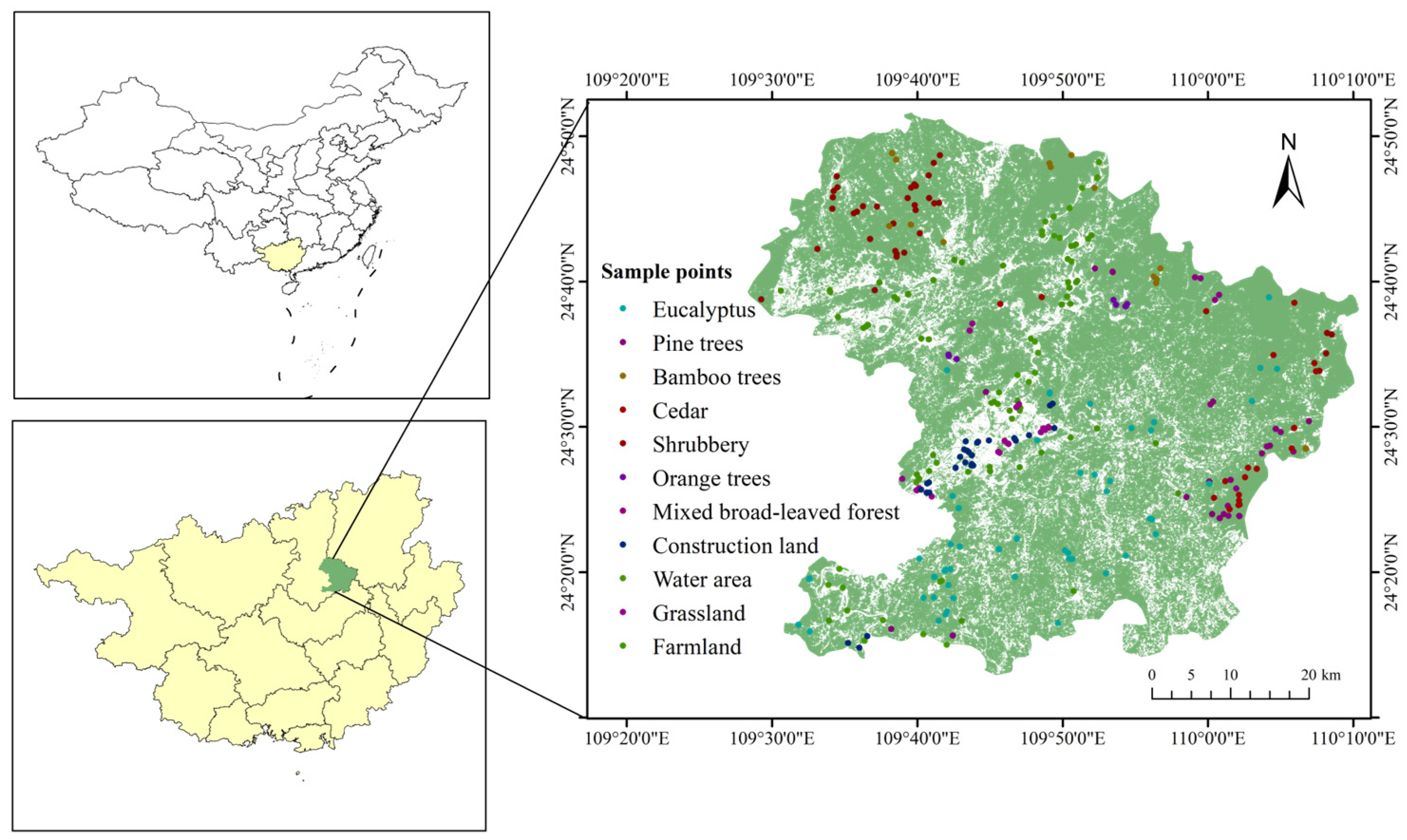

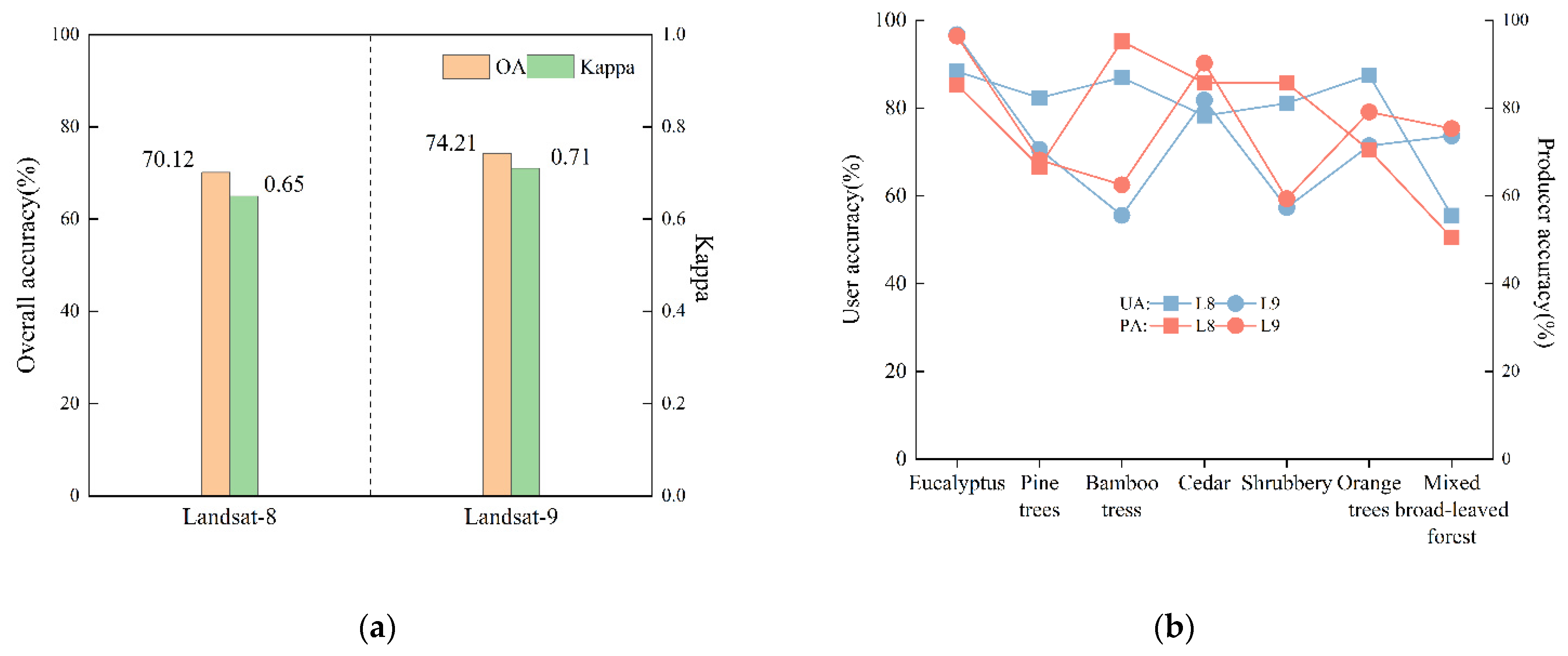
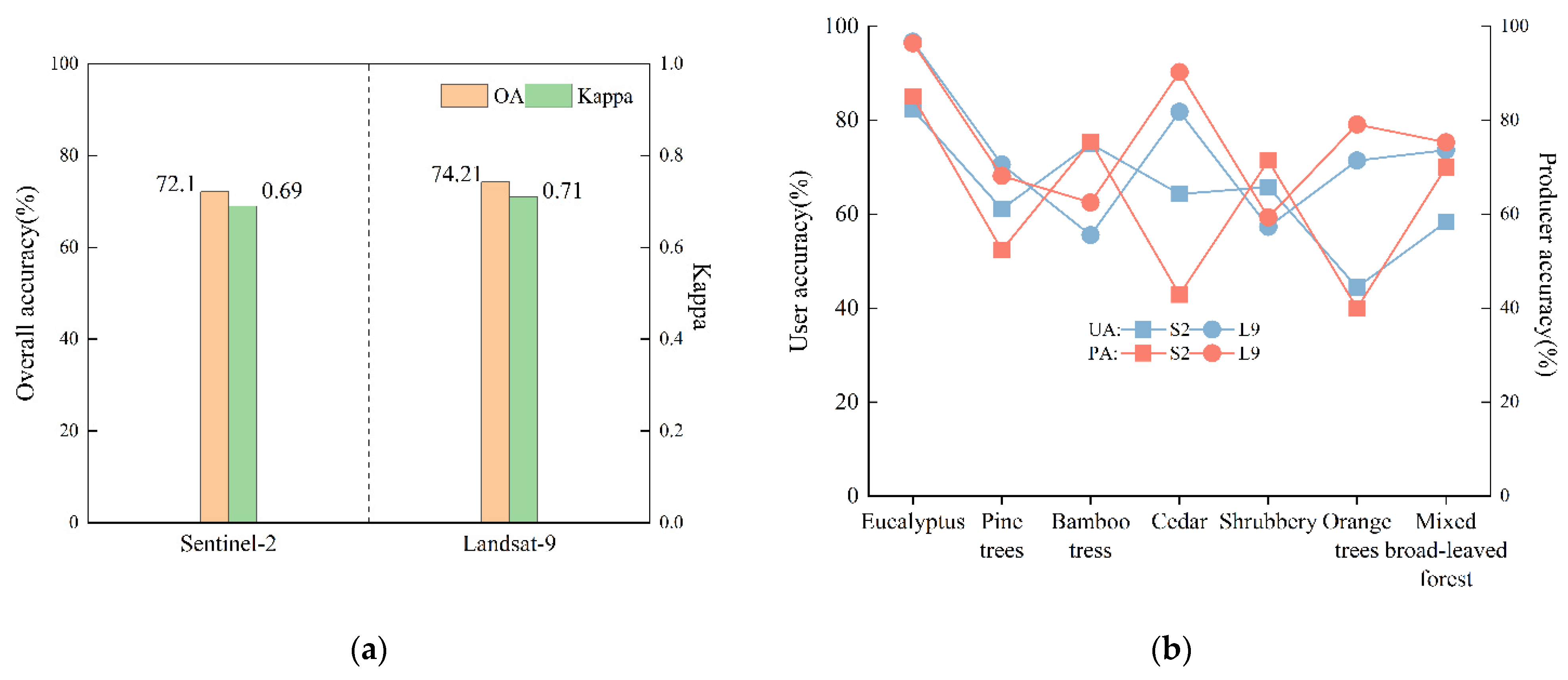
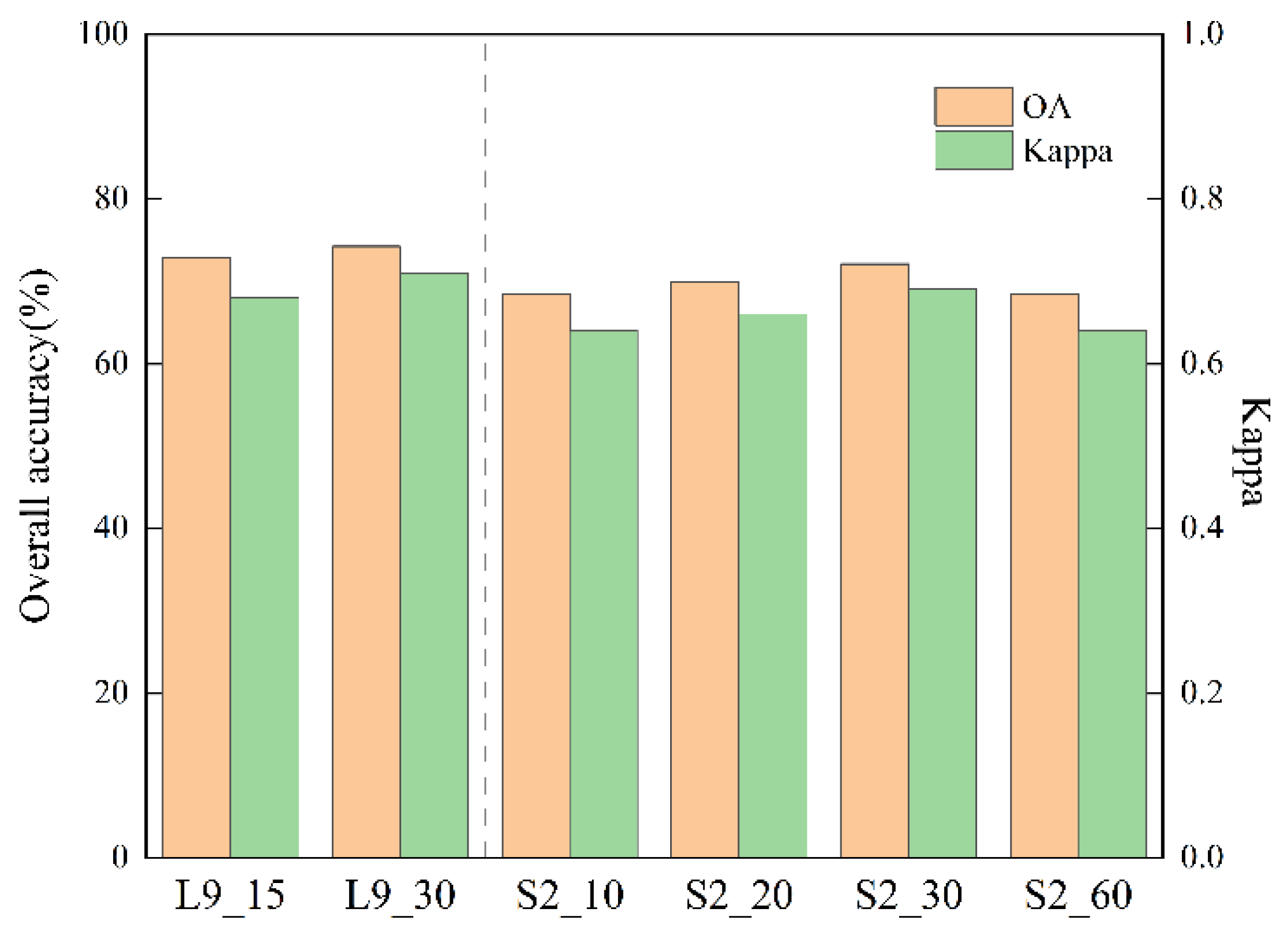

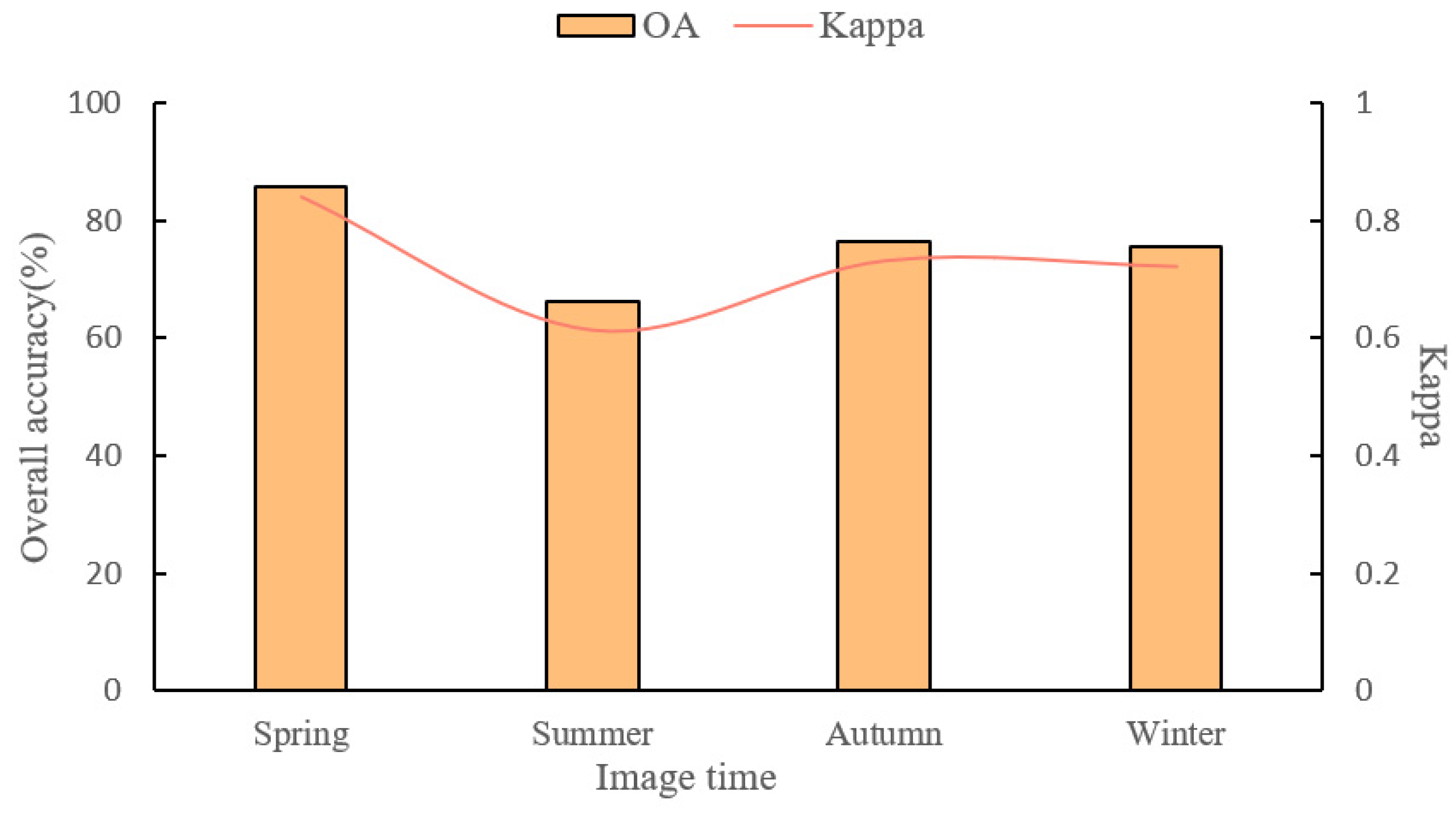
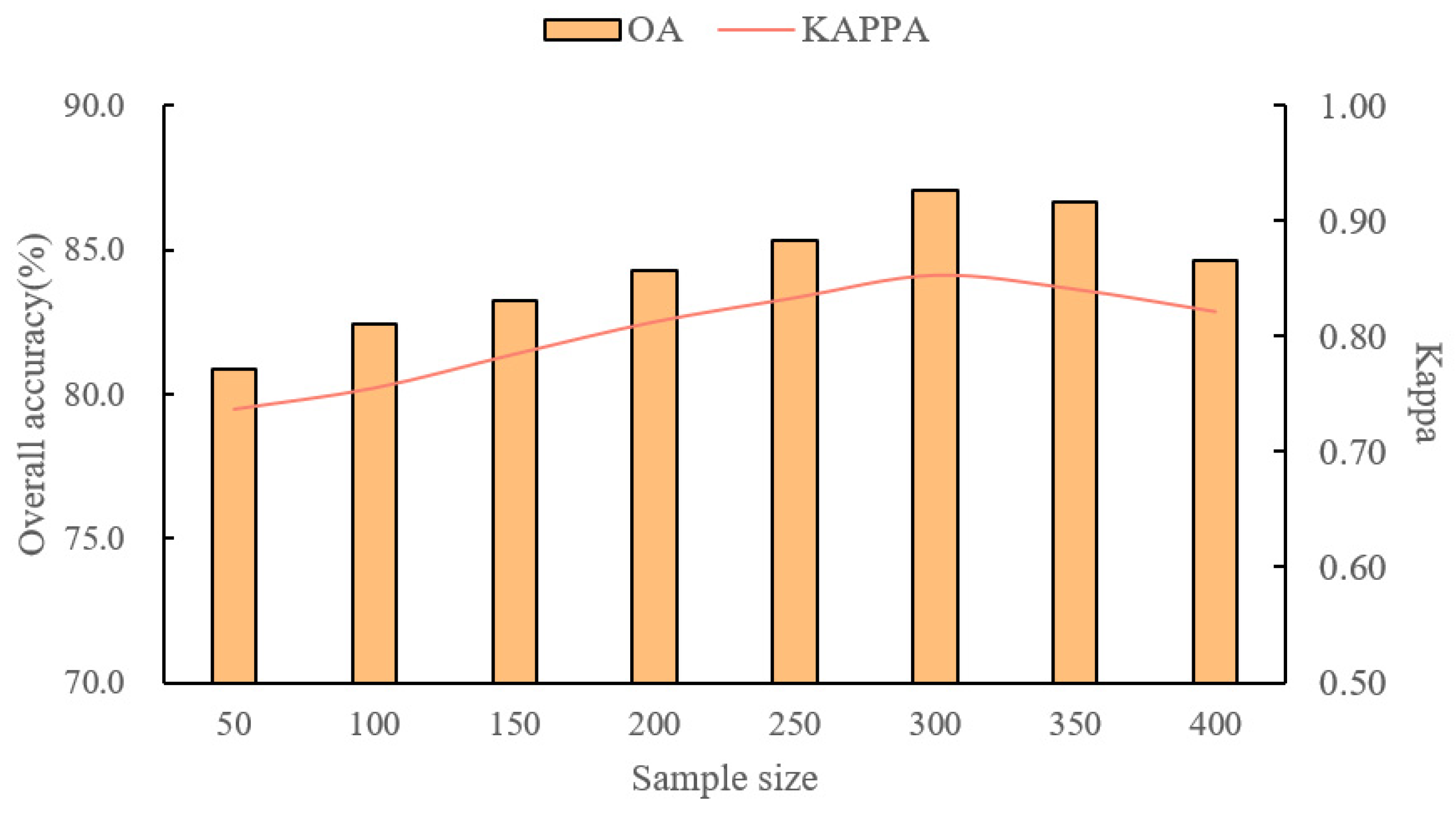
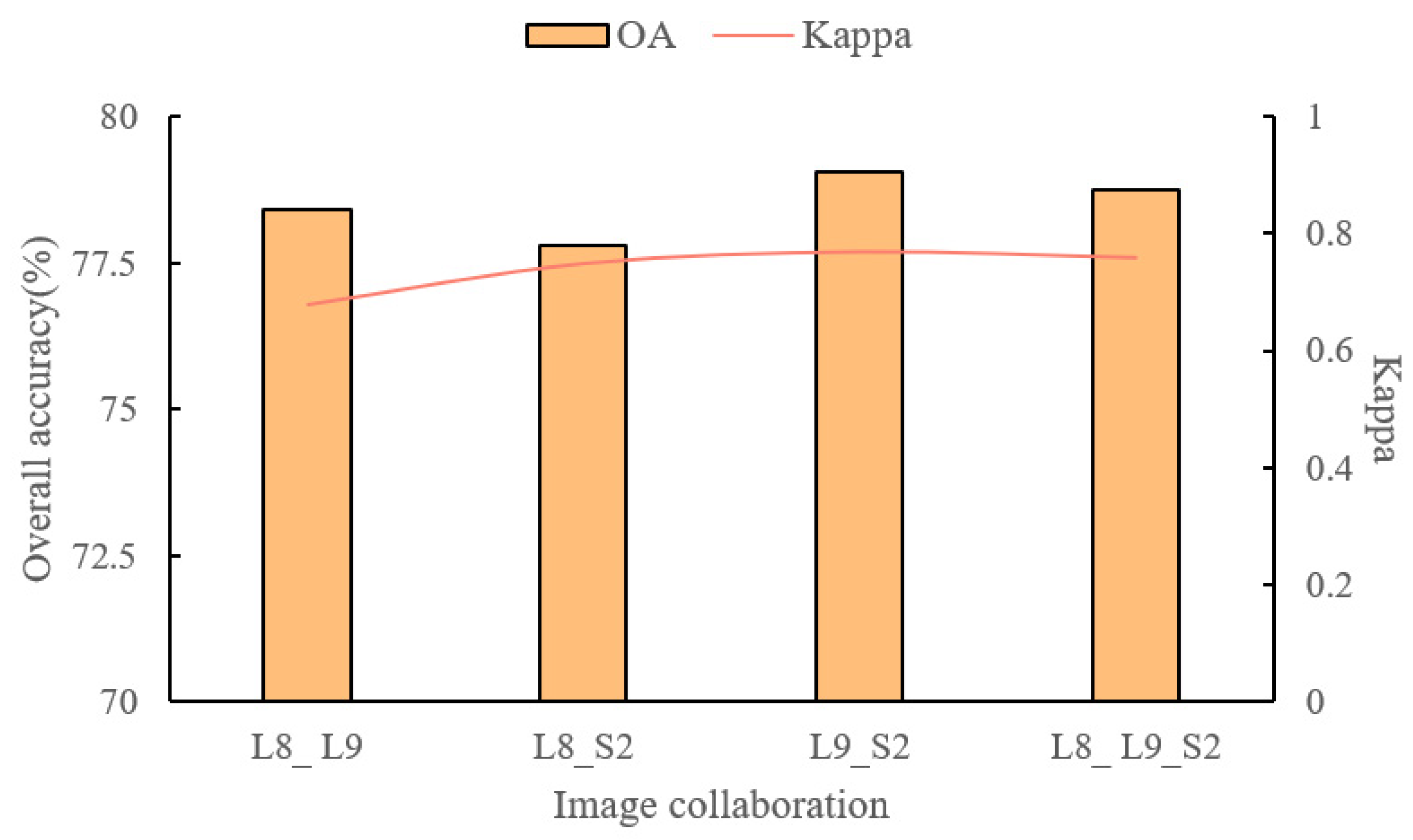
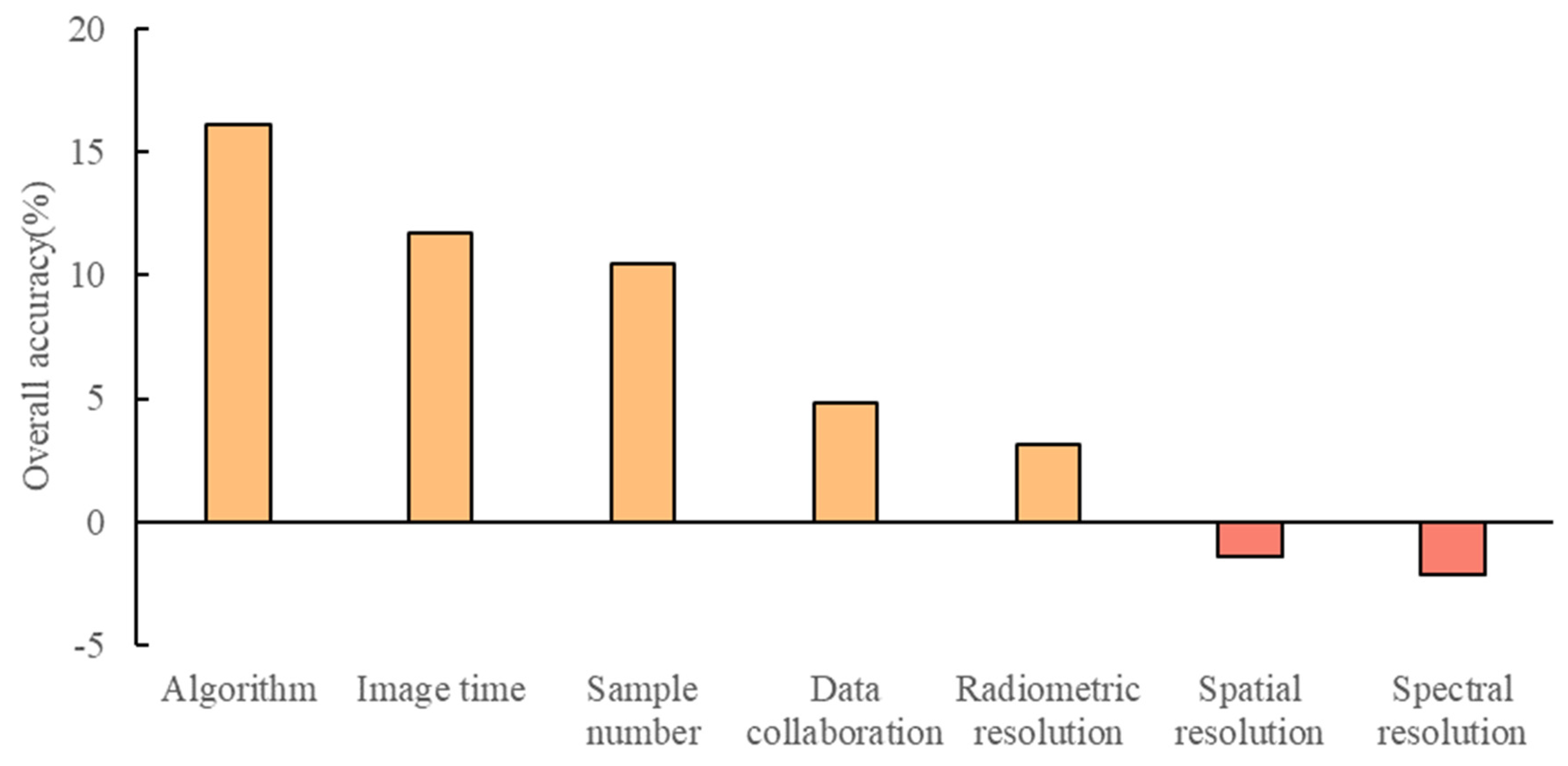
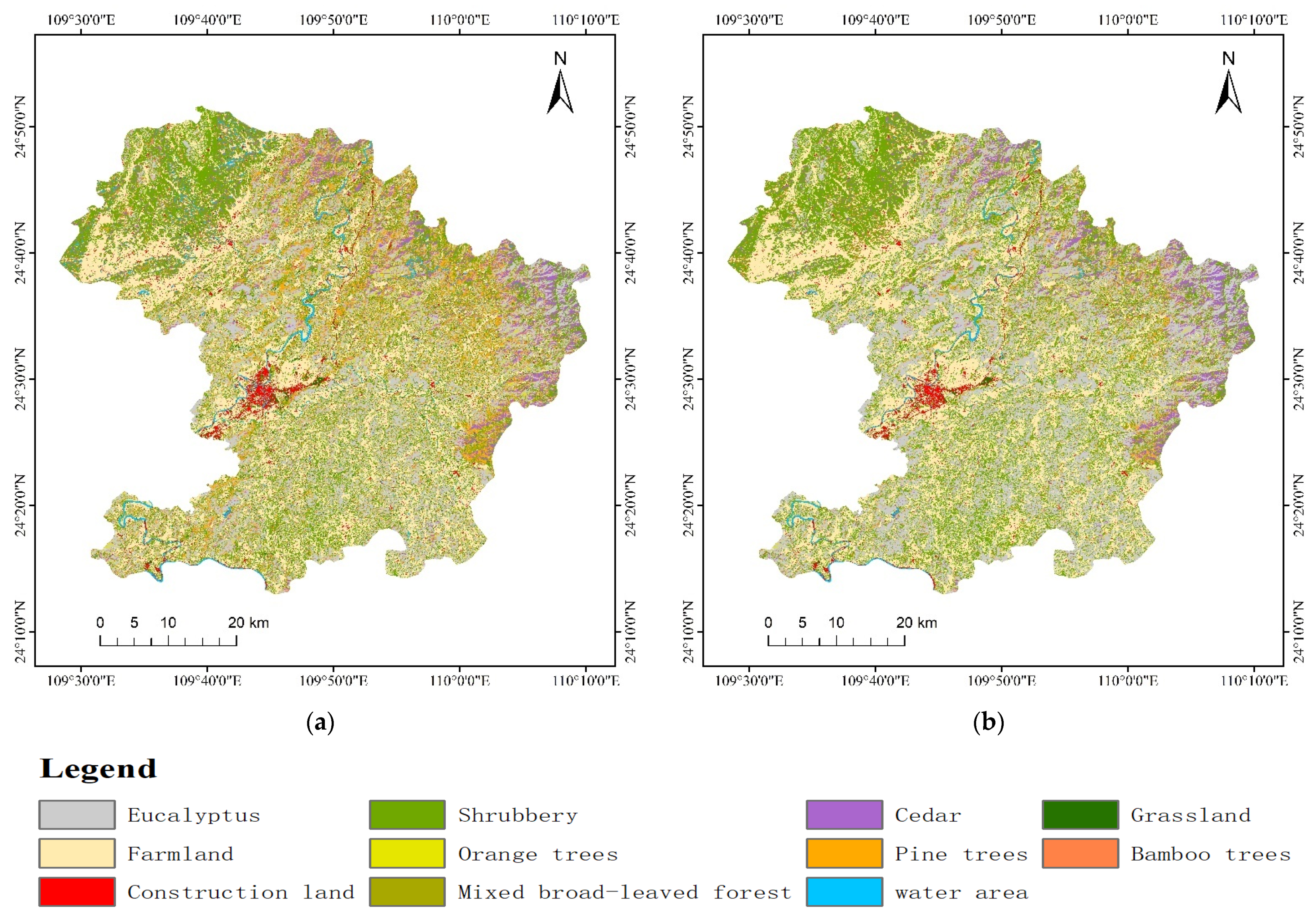
| Categories | Number of Samples |
|---|---|
| Eucalyptus | 60 |
| Bamboo trees | 35 |
| Pine trees | 35 |
| Cedar | 35 |
| Orange trees | 35 |
| Shrubbery | 35 |
| Mixed broad-leaved forest | 30 |
| Water area | 30 |
| Farmland | 60 |
| Construction land | 25 |
| Grassland | 25 |
| Sensor | Band | Wavelength/μm | Radiometric Resolution/Bit | Image Time Used |
|---|---|---|---|---|
| OLI/OLI-2 | Band 1 | 0.435–0.451/0.435–0.450 | 12/14 | OLI images from December 2022 OLI-2 images from March 2022 to March 2023 |
| Band 2 | 0.452–0.512/0.452–0.512 | 12/14 | ||
| Band 3 | 0.533–0.590/0.532–0.589 | 12/14 | ||
| Band 4 | 0.636–0.673/0.636–0.672 | 12/14 | ||
| Band 5 | 0.851–0.879/0.850–0.879 | 12/14 | ||
| Band 6 | 1.566–1.651/1.565–1.651 | 12/14 | ||
| Band 7 | 2.107–2.294/2.105–2.294 | 12/14 | ||
| Band 8 | 0.504–0.676/0.503–0.675 | 12/14 | ||
| Band 9 | 1.363–1.384/1.363–1.384 | 12/14 |
| Band | Wavelength/(μm) | Spatial Resolution (m) | Image Time Used |
|---|---|---|---|
| B1 (Aerosols) | 0.443–0.453 | 60 | December 2022 |
| B2 (Blue) | 0.458–0.523 | 10 | |
| B3 (Green) | 0.543–0.578 | 10 | |
| B4 (Red) | 0.650–0.680 | 10 | |
| B5 (Red Edge 1) | 0.698–0.713 | 20 | |
| B6 (Red Edge 2) | 0.733–0.748 | 20 | |
| B7 (Red Edge 3) | 0.773–0.793 | 20 | |
| B8 (NIR) | 0.785–0.900 | 10 | |
| B8a (VNIR) | 0.855–0.875 | 20 | |
| B9 (Water vapor) | 0.935–0.955 | 60 | |
| B10 (SWIR Cirrus) | 1.360–1.390 | 60 | |
| B11 (SWIR 1) | 1.565–1.655 | 20 | |
| B12 (SWIR 2) | 2.100–2.280 | 20 |
| Features | Data | Feature Variable |
|---|---|---|
| Spectral reflectance | Sentinel-2 | Band 1, Band 2, Band 3, Band 4, Band 5, Band 6, Band 7, Band 8, Band 8A, Band 9, Band 11, Band 12 |
| Landsat-9 | Band 1, Band 2, Band 3, Band 4, Band 5, Band 6, Band 7, Band 8, Band 9, Band 10, Band 11 | |
| Spectral indices | Sentinel-2 | NDVI, TCARI, TVI, NDWI, SAVI, MSI, LSWI, RDVI, MCARI, NDVI red_ edge, mNDVIred_edge, MSRred_edge, CIred_edge |
| Landsat-9 | NDVI, NDWI, TCARI, RDVI, MCARI, TVI, SAVI, MSI, LSWI | |
| Texture features | Sentinel-2 | Texture metrics are derived from the co-occurrence matrix calculated for each pixel across every spectral band, with each band producing 18 distinct texture features |
| Landsat-9 |
| Landsat-8 | Landsat-9 | Sentinel-2 | ||||
|---|---|---|---|---|---|---|
| OA/% | Kappa | OA/% | Kappa | OA/% | Kappa | |
| RF | 70.12 | 0.65 | 74.21 | 0.71 | 68.38 | 0.64 |
| GTB | 66.43 | 0.61 | 70.12 | 0.66 | 65.62 | 0.63 |
| SVM | 59.38 | 0.53 | 58.13 | 0.51 | 63.25 | 0.60 |
Disclaimer/Publisher’s Note: The statements, opinions and data contained in all publications are solely those of the individual author(s) and contributor(s) and not of MDPI and/or the editor(s). MDPI and/or the editor(s) disclaim responsibility for any injury to people or property resulting from any ideas, methods, instructions or products referred to in the content. |
© 2024 by the authors. Licensee MDPI, Basel, Switzerland. This article is an open access article distributed under the terms and conditions of the Creative Commons Attribution (CC BY) license (https://creativecommons.org/licenses/by/4.0/).
Share and Cite
Lai, X.; Tang, X.; Ren, Z.; Li, Y.; Huang, R.; Chen, J.; You, H. Study on the Influencing Factors of Forest Tree-Species Classification Based on Landsat and Sentinel-2 Imagery. Forests 2024, 15, 1511. https://doi.org/10.3390/f15091511
Lai X, Tang X, Ren Z, Li Y, Huang R, Chen J, You H. Study on the Influencing Factors of Forest Tree-Species Classification Based on Landsat and Sentinel-2 Imagery. Forests. 2024; 15(9):1511. https://doi.org/10.3390/f15091511
Chicago/Turabian StyleLai, Xin, Xu Tang, Zhaotong Ren, Yuecan Li, Runlian Huang, Jianjun Chen, and Haotian You. 2024. "Study on the Influencing Factors of Forest Tree-Species Classification Based on Landsat and Sentinel-2 Imagery" Forests 15, no. 9: 1511. https://doi.org/10.3390/f15091511





